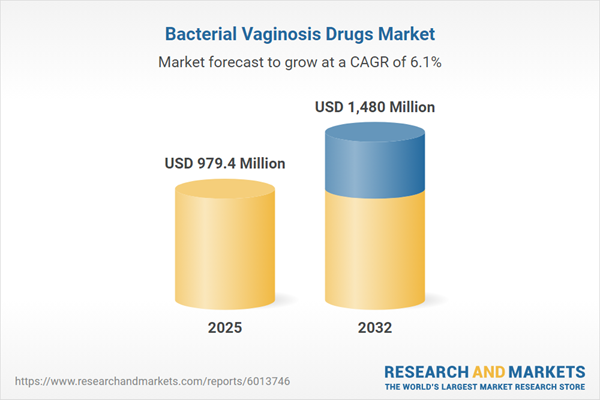Speak directly to the analyst to clarify any post sales queries you may have.
The Bacterial Vaginosis Drugs Market is rapidly evolving as industry stakeholders respond to ongoing innovation, tighter regulatory oversight, and patient-centric healthcare trends. Success depends on mapping changing dynamics, identifying competitive pressures, and leveraging emerging therapeutic and commercial opportunities.
Market Snapshot: Bacterial Vaginosis Drugs Market Overview
The Bacterial Vaginosis Drugs Market grew from USD 921.92 million in 2024 to USD 979.40 million in 2025. It is projected to expand at a CAGR of 6.10%, ultimately reaching USD 1.48 billion by 2032. The market’s strong trajectory highlights resilient demand and underscores its significance within women’s health therapeutics, reflecting growing awareness, dynamic regulatory guidance, and advances in underlying treatment technologies.
Scope & Segmentation
- Drug Classes: Antibiotics—Clindamycin, Metronidazole, Tinidazole—and antiseptic therapies with distinct efficacy and resistance profiles.
- Route of Administration: Oral and vaginal therapies, each offering advantages in adherence or patient preference.
- Dosage Forms: Creams, gels, suppositories, and tablets supporting diverse clinical needs and improving user experience.
- Distribution Channels: Hospital pharmacies, online platforms, and retail pharmacies providing broad patient access and procurement options.
- End Users: Clinics, home healthcare, and hospitals—each with unique engagement priorities and workflow requirements.
- Regions: Americas—including North and Latin America; Europe, Middle East & Africa; and Asia-Pacific. The scope incorporates the United States, Canada, Brazil, Germany, China, India, and additional regional markets where drug adoption, regulation, and partnership patterns are driving development.
- Key Companies Covered: Teva Pharmaceutical Industries Ltd., Pfizer Inc., Sandoz Inc., Viatris Inc., Dr. Reddy's Laboratories Ltd, Lupin Limited, Cipla Limited, Perrigo Company plc, Gedeon Richter Plc, Glenmark Pharmaceuticals Limited.
Bacterial Vaginosis Drugs Market: Key Takeaways
- Microbial imbalance and recurrence patterns in bacterial vaginosis create ongoing clinical and commercial challenges, emphasizing the importance of novel formulations.
- Digital health solutions and telemedicine are facilitating patient engagement, enhancing adherence, and supporting remote monitoring in ongoing therapies.
- Strategic collaborations between pharmaceutical manufacturers and diagnostic developers are enabling precision medicine initiatives and innovative delivery platforms.
- Tailored regional strategies are critical as regulatory diversity and local reimbursement policies shape market entry and access models.
- Intellectual property management and advanced formulation patents remain vital for sustaining competitive differentiation and lifecycle management in this sector.
Tariff Impact: Supply Chain and Trade Considerations
U.S. tariff policies affecting bacterial vaginosis therapeutics have intensified supply chain cost pressures. Manufacturers are re-evaluating sourcing arrangements and cost structures to manage heightened duties on raw and intermediate imports. Consequently, logistics optimization and contract renegotiation are increasingly essential for distributors and wholesalers aiming to protect margins. Healthcare providers are exploring cost-effective options, spurring interest in generic alternatives and reshaping prescribing decisions.
Methodology & Data Sources
This analysis combines primary interviews with clinicians, industry leaders, and supply chain specialists, supplemented by peer-reviewed publications, regulatory documents, and public health datasets. Quantitative data is validated and anonymized; qualitative data is coded and cross-verified for emerging stakeholder perspectives.
Why This Report Matters
- Provides critical benchmarking for manufacturers, distributors, and investors navigating a shifting B2B therapeutics market.
- Enables data-driven strategy formulation by integrating regulatory changes, clinical advancements, and regional market dynamics.
- Delivers actionable insights into commercial risks, emerging trends, and innovation opportunities across the bacterial vaginosis landscape.
Conclusion
The Bacterial Vaginosis Drugs Market continues to reflect evolving clinical, regulatory, and commercial realities. Data-driven stakeholder engagement and integrated innovation are increasingly decisive in responding to patient needs and achieving sustainable growth in women’s healthcare.
Additional Product Information:
- Purchase of this report includes 1 year online access with quarterly updates.
- This report can be updated on request. Please contact our Customer Experience team using the Ask a Question widget on our website.
Table of Contents
3. Executive Summary
4. Market Overview
7. Cumulative Impact of Artificial Intelligence 2025
Companies Mentioned
The companies profiled in this Bacterial Vaginosis Drugs market report include:- Teva Pharmaceutical Industries Ltd.
- Pfizer Inc.
- Sandoz Inc.
- Viatris Inc.
- Dr. Reddy's Laboratories Ltd
- Lupin Limited
- Cipla Limited
- Perrigo Company plc
- Gedeon Richter Plc
- Glenmark Pharmaceuticals Limited
Table Information
| Report Attribute | Details |
|---|---|
| No. of Pages | 199 |
| Published | October 2025 |
| Forecast Period | 2025 - 2032 |
| Estimated Market Value ( USD | $ 979.4 Million |
| Forecasted Market Value ( USD | $ 1480 Million |
| Compound Annual Growth Rate | 6.1% |
| Regions Covered | Global |
| No. of Companies Mentioned | 11 |









